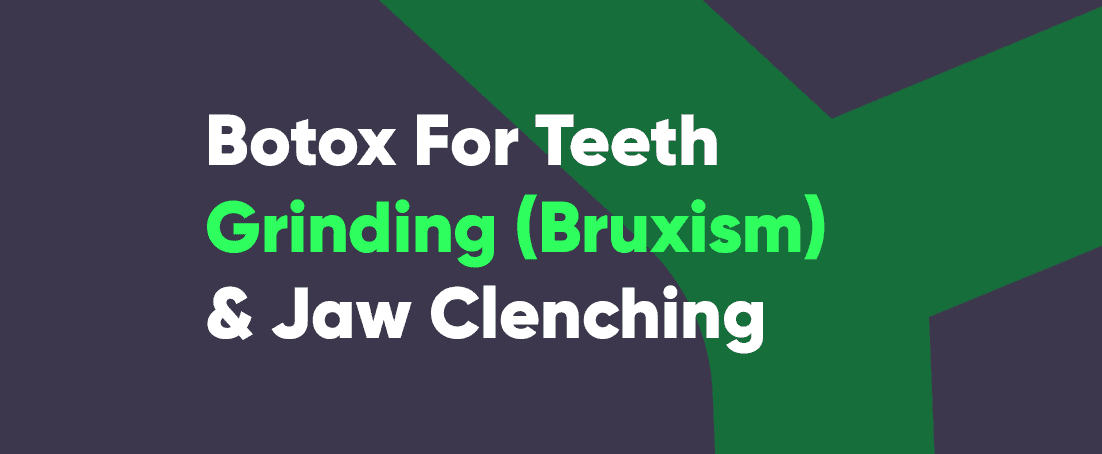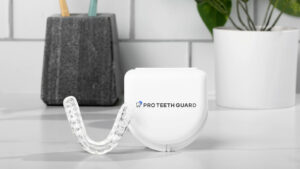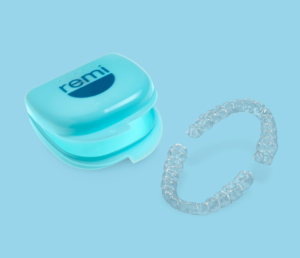
Wondering why you wake up with headaches, face pain, or cracked teeth? You must be experiencing bruxism while asleep. Also known as teeth grinding and jaw clenching, these unintentional practices get in the way of a good night’s sleep.
Botox, commonly used in cosmetic procedures, is a surprise solution for these teeth problems. It’s neurotoxin generated from the bacterium Clostridium botulinum, which works by relaxing facial muscles involved in grinding.
This article is a guide to help you explore effective alternatives for long-term management of teeth grinding and jaw clenching issues. Let’s dive in!
What’s Up with Botox and Teeth Grinding?
Botox has emerged as an unexpected yet increasingly popular treatment for teeth grinding. The treatment seeks to ease stress and end unconscious grinding and clenching. This occurs by injecting Botox into the muscles responsible for jaw movement.
Botox for teeth grinding procedures weakens the muscles and prevents muscular contractions that result in grinding. While it has traditionally been used to smooth skin wrinkles and enlarge lips, botox for bruxism is gaining popularity due to its efficiency to relieve jaw muscles.
The effects last a few months, after which follow-up treatments may be necessary. Botox injections for bruxism are an off-label use. They are not an FDA-approved treatment for grinding. Healthcare professionals use it based on their clinical judgment and patient needs. The procedure is administered mainly through injections.
The Science Behind Botox Treatment for Bruxism
The Masseter Muscle in Bruxism and Botox Use
The masseter is one of the key muscles on both sides of the face, responsible for chewing and jaw movement. These powerful muscles control jaw movement when chewing. When this muscle contracts, it causes an intense rise of the mandible, making your mouth close. Other four muscles assist it in performing its functions:
- Temporalis
- Lateral pterygoid
- Buccinator
- Medial pterygoid
Masseter muscle also helps to stabilize the temporomandibular joint (TMJ) when teeth clench. TMJ is where the jaw joins the skull just below the ears. It’s common to experience tenderness and facial pain in this area.
The muscles may overdevelop due to persistent strain, resulting in involuntary grinding and clenching. Masseter Botox for teeth grinding entails injecting botulinum toxin into the masseter muscles. According to research, injecting Botox into the muscles, weakens them, lowering their powerful contractions. This intervention is effective and assists in reducing the excessive pressure and jaw tension exerted during grinding and clenching.
Excessive pressure on the teeth caused by overdeveloped masseter muscles may cause discomfort, jaw pain, migraines and dental difficulties.
These muscles can become overdeveloped due to persistent strain, resulting in involuntary grinding and clenching. The cases of overdevelopment are:
- Chronic teeth clenching
- Grinding (bruxism)
- Excessive jaw strain
When these your oral muscles are overworked and hypertrophied, they increase muscle mass and jaw strain. This results in a squared or broader jawline, which even aggravates bruxism-related symptoms.
Technicalities of How Botox Treats Bruxism
Botox injections work by targeting the nerve-muscle connection to relax the jaw muscles. Botox treatment for bruxism works by injecting botulinum toxin into the masseter muscles, responsible for jaw movement.
The active ingredient inhibits the release of acetylcholine, a neurotransmitter required for muscular contractions. Botox weakens the targeted muscles by interfering with the nerve signals that initiate muscular action.
Using Botox to treat bruxism makes the weaker masseter muscles less receptive to nerve signals. This is the best, especially when severe teeth grinding and jaw clenching cause stress and discomfort. Their capacity to contract powerfully is diminished, resulting in jaw muscular relaxation. This relaxation reduces the intensity of grinding and clenching. As a result, it relieves discomfort and minimizes excessive teeth wear.
Botox injections for bruxism have a short-term effect. They often last several months, after which re-injection may be required to keep the muscles relaxed.
Botulinum Toxin Safety for Jaw Clenching
Botox for jaw clenching is considered safe when administered by a competent expert. It momentarily relaxes muscles, minimizing clenching. Gentle facial exercises after Botox injections might help you recuperate after injections.
Engaging in low intensity facial movements post-injection, like smiling or frowning, helps distribute the Botox more evenly. However, consult with your healthcare provider for specific guidance on the safest ways of recovery after treating clenching with Botox.
The Risks of Botox for Grinding Teeth
Botox for bruxism risks include the following:
- Pain and Discomfort: Some people may suffer pain, soreness, or discomfort at the injection sites. This can vary in intensity and duration but usually disappears after a few days.
- Difficulty Chewing or Speaking: Fluctuating paralysis of the jaw muscles can cause difficulty in chewing or speaking, especially right after therapy. This is usually temporary and improves when the Botox’s effects wear off.
- Weakened Jaw Muscles: Excessively relaxed muscles can cause transient weakness in the jaw, affecting chewing and facial expressions. This resolves once the Botox’s effects wear off.
- Headaches or Migraines: Although Botox is frequently used to treat headaches, some people may have headaches as a side effect of the therapy.
- Asymmetry in Facial Expression: Because the masseter muscles relax unevenly, improperly given bruxism, Botox can cause an imbalance in facial expression.
- Allergic Reactions: Rare allergic reactions to Botox for clenched jaw can occur, causing itching, redness, disorientation, or difficulty breathing. If such reactions occur, seek immediate medical assistance.
- Bruising or Swelling: Temporary bruising or swelling may occur at injection sites. This is a frequent side effect of Botox for clenching jaw that usually goes away after a few days.
- Rare but Severe Consequences: Severe consequences may occur in rare circumstances, such as spreading the toxin to neighboring tissues. This causes muscle weakness or difficulties swallowing. These are extremely rare, but if they occur, they must be treated immediately.
Assesing Botox Treatment Cost for Dental Health
The cost of Botox for bruxism treatment varies largely. It depends on various factors, including:
- Geographic location
- Practitioner experience
- The quantity of Botox units or products utilized
- Specific clinic pricing rules
Botox injections for bruxism TMJ cost in a range from $500 to $700 per treatment session. More elaborate treatments of Botox, such as numerous injections or greater doses, may cost you around $2,000.
Botox treatment for tooth grinding is not always covered by insurance since it’s a cosmetic or elective operation in many circumstances. Some insurance companies, however, may cover Botox treatment for bruxism.
Botox for teeth grinding covered by insurance happens when it’s deemed medically necessary and supported by sufficient evidence from a healthcare provider.
Persons seeking Botox for teeth grinding should weigh the potential advantages against the related costs.
Botox therapy is beneficial for lowering muscular activity, alleviating discomfort, and reducing the consequences of bruxism. It may relieve pain and probable dental damage caused by grinding teeth.
Botox Alternatives for Treating Bruxism
You may want to consider non-invasive treatments, such as mouth or night guards, before using Botox for teeth clenching. Professionals frequently recommend these types of custom-fit dental appliances.
Mouth guards serve as a barrier between teeth, avoiding damage from clenching or grinding. They are comfortable to use while sleeping and help reduce bruxism impact. These solutions are popular due to their safety and capacity to treat teeth clenching without the relatively intrusive treatments such as Botox injections.
Night Guards for Teeth Clenching
Night guards, an alternative to Botox for teeth clenching and grinding, offer adequate protection against dental damage. Article on our recommended night guard picks is an astonishing source of information that will guide and help you pick the best options. However, if you’re seeking to save time, then take a look at the top products in the niche which will help you minimize bruxism’s impact while ensuring comfort and uninterrupted sleep.


Crafted for a secure and precise fit, these guards prevent teeth grinding, ensure restful nights, and provide lifelong dental protection. You may want to dive deeper for:
- A professional review of Pro teeth guard, which highlights its precision and durability, making it a top choice for users seeking long-term dental care.
- An in-depth analysis of Remi mouth guards, on the other hand, focuses on their tailored comfort and high-quality materials.
These guards are tailored to prevent dental damage caused by bruxism, offering a durable and effective solution. I Emphasize their quality materials and comfort, positioning them as a reliable choice for those seeking comprehensive protection against teeth clenching.
Night guards stand out as a preferred and non-invasive alternative to Botox, offering a range of benefits, like comfort, precision and longevity, compared to the botulin injections. They also prevent the effects of bruxism while ensuring better oral health and peaceful sleep.
Mewing for Managing Bruxism
Mewing is a natural jaw training technique that involves positioning the tongue against the palate. The goal is to improve facial structure and assist with teeth grinding. The procedure also helps enhance jawline definition and alleviate Temporomandibular Joint Disorder (TMD) symptoms.
Unlike Botox injections, mewing is non-invasive and enhances facial symmetry and jawline development without using external ingredients. It provides broader benefits than only reducing teeth grinding, including improving jawline contouring, providing a non-invasive alternative for those seeking cosmetic improvement, and enhancing overall facial attractiveness. For more information, this piece has everything you need to know about mewing.
While scientific evidence is lacking, mewing delivered some impressive results because of its ability to naturally contour the jawline, enhancing dental health.
In addition to mewing, incorporating targeted facial exercises can further aid in managing bruxism and promoting overall oral health. For instance, exercises specifically designed to lift drooping mouth corners can complement your efforts to alleviate symptoms of bruxism and improve facial aesthetics.
Jaw Exercisers as a Non-Botox Approach for Clenching
Jaw exercisers use repetitive chewing motions to improve the jaw muscles. They are probably the best jawline training tools that, as opposed to Botox injections, aim to improve muscle tone, potentially reducing teeth grinding, increasing jawline definition, and alleviating TMJ disorder symptoms.
Jaw muscle training devices, such as silicone chewies or bite strips, are non-invasive and natural. They tackle the fundamental cause of jaw-related disorders rather than temporarily suppressing muscular action by boosting muscle strength and endurance.
Jaw exercisers are a non-surgical and cost-effective way to improve dental health and face beauty by stressing muscle growth over muscle relaxation.
Summing Up Bruxism Solutions Beyond Botox Treatment
Botox for teeth grinding and jaw clenching provides temporary comfort by relaxing muscles. However, potential side effects include transient weakening and asymmetry.
Alternatives to botox for jaw grinding, such as mouth guards, mewing, or jaw exercises, offer non-invasive, long-term therapies. They significantly address the underlying issues. It’s critical to speak with a dentist or dermatologist about the risks and benefits of each technique.
The reason why dentists recommend wearing mouth guards is because they’re safe and effective, and they help avoid bruxism-related dental damage.
Prioritize safety and seek comprehensive approaches that address the underlying concerns, assuring optimal teeth grinding and jaw clenching management for improved oral health and well-being.



